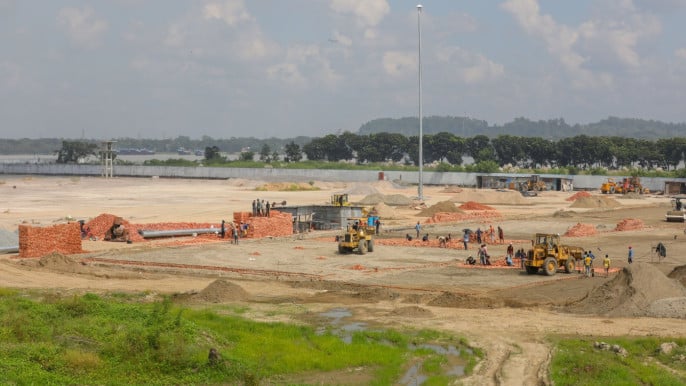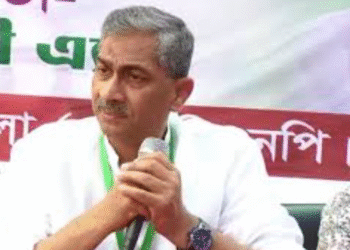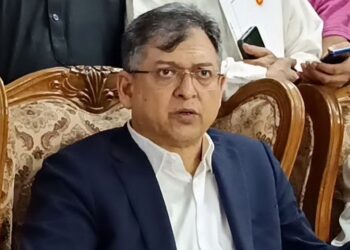Key Highlights:
- Maersk subsidiary APM Terminals BV to design, finance, build, and operate Laldia Container Terminal at Chattogram Port under a 30-year PPP agreement.
- Signing money: Tk250 crore to be paid to Bangladesh as part of the deal.
- Total investment: $550 million (~Tk6,700 crore) over three years for construction, equipment, and operational setup.
- Revenue-sharing model: $21 per TEU, increasing to $23 for volumes above 900,000 TEUs.
- Terminal capacity: Over 800,000 TEUs per year (+44% vs current capacity); ships twice the size of current New Mooring Terminal vessels can dock.
- Construction timeline: Expected to start in December 2025 and operational by 2029.
- Job creation: 500–700 direct jobs and thousands of indirect jobs.
- Global standards: State-of-the-art green port with advanced technology, safety, and climate-resilient infrastructure.
- Strategic impact: Enhances Bangladesh’s port efficiency, foreign investment potential, and logistics sector readiness in the post-LDC era.
Maersk’s Laldia Terminal Project: A Transformative PPP Initiative
Bangladesh is set to witness a historic milestone in its port sector as Netherlands-based APM Terminals BV, a subsidiary of Danish shipping giant Maersk, will develop the Laldia Container Terminal at Chattogram Port. The interim government has approved a 30-year public-private partnership (PPP) agreement, under which APM Terminals will design, finance, build, and operate the terminal while ownership remains with the Chattogram Port Authority (CPA).
The final concession agreement is scheduled to be signed next week, as confirmed by Chowdhury Ashik Mahmud Bin Harun, CEO of the Public Private Partnership Authority.
Financial Overview: Investment and Returns
As part of the agreement:
- Signing money: Tk250 crore to Bangladesh upon agreement execution.
- Total investment: Approximately $550 million (~Tk6,700 crore) over three years, covering construction, equipment, and operations.
- Revenue-sharing model: $21 per TEU handled, increasing to $23 per TEU for annual volumes exceeding 900,000 TEUs; rates gradually decrease beyond that to safeguard CPA’s revenue.
The project represents a pure foreign direct investment (FDI), with APM Terminals bringing in the largest European equity investment in Bangladesh to date.
Read more: I promised that no matter how powerful, I would get what I deserve: Tajul Islam
Strategic and Operational Significance
The Laldia Container Terminal is designed to elevate Bangladesh’s port sector to global standards. Key features include:
- Capacity expansion: Over 800,000 TEUs per year (+44% vs current capacity).
- Ship accommodation: Vessels twice the size of those docking at the New Mooring Container Terminal (NCT).
- Operational efficiency: Faster vessel turnaround, reduced dwell time, and 24/7 port operations with night navigation capabilities.
- Technology transfer: Deployment of advanced terminal operations, LEAN methodology, FLOW operational frameworks, and environmental protocols.
- Greener infrastructure: Energy-efficient equipment, climate-resilient facilities, supporting Bangladesh’s Paris Agreement commitments.
The project is expected to modernize Bangladesh’s logistics sector, reduce trade costs, and enhance global competitiveness, particularly for exporters in time-sensitive sectors such as RMG, agro-processing, and light engineering.
Economic and Employment Impact
The Laldia Terminal project is projected to generate:
- Direct employment: 500–700 jobs.
- Indirect employment: Thousands across construction, trucking, warehousing, freight forwarding, and SMEs.
- Revenue growth: Higher throughput and efficiency will increase CPA’s revenue in USD/TEU and generate additional tax revenue.
- Catalyst for development: Encourages private investment in inland container depots, cold chains, industrial parks, and broader regional economic activity.
Governance, Oversight, and Long-term Vision
The project follows a government-to-government (G2G) PPP framework, ensuring:
- Ownership remains with CPA: APM Terminals will operate and manage the terminal for 30 years, with an option to extend the term.
- Global operational standards: Ensures high efficiency, reduced corruption, and internationally benchmarked safety protocols.
- Knowledge and skill transfer: Upskilling of local engineers, technicians, and managers.
- Demonstration effect: Signals Bangladesh’s ability to structure and oversee complex PPP projects, attracting additional international investors.
Environmental and Sustainability Focus
The terminal is designed as a state-of-the-art green port:
- Energy-efficient operations to reduce carbon emissions.
- Climate-smart infrastructure supporting Bangladesh’s NDC under the Paris Agreement.
- Positioning Bangladesh as a green pioneer in regional logistics and port development.
Official Statements
Chowdhury Ashik Mahmud Bin Harun, CEO of the PPP Authority and BIDa, emphasized:
Addressing the briefing, Ashik said,
“I am speaking today as the chief executive officer of the PPP Authority. The Laldia Container Terminal project will elevate Bangladesh’s port sector to global standards.”
He also said,
“This is not just an infrastructure investment, but a step toward making Bangladesh’s logistics sector ‘future-ready’, ushering in a new era for our exports, employment, and foreign investment.”
Ashik Chowdhury said,
“Today we presented the Laldia Container Terminal project to the Cabinet Committee on Economic Affairs. They have approved it. Our next task is to sign the concession agreement, which will take place next week.”
He added that,
“After that, they can begin work. Next week, the chairman of APM Terminals’ global headquarters and a minister from Denmark will come to celebrate the signing.”
“We expect that if construction starts in December, the terminal will be operational by 2029,” he said.
Referring to the development of the Laldia Container Terminal the PPP chief said, the land they are providing is currently like an open green field and APM Terminals will build the terminal from the baseline — first constructing the jetty and then operating the port.
Mentioning that the ownership will remain with the Chittagong Port Authority, Ashik said they (APM Terminals) will build the terminal and after 30 years, there will be an option to extend the term.
“If not extended, they will hand over the entire asset to us after 30 years. This will be a pure foreign direct investment (FDI) for us,” said Asik, who is also the chief of Bangladesh Investment Development Authority (Bida).
“The initial investment of $550 million — around Tk6,700 crore — will be made over the next three years. The amount will cover construction, equipment installation, and other expenses. As signing money, they will pay Tk250 crore,” he added.
“For every TEU, they will pay us $21,” he said, adding that if the annual volume exceeds 900,000 TEUs, it will be $23 per TEU.
“As the number goes even higher, the rate will gradually decrease. Our focus was to ensure that the Chittagong Port Authority does not incur any losses,” he said.
Source: TBS

















